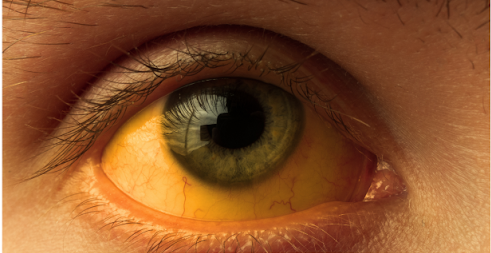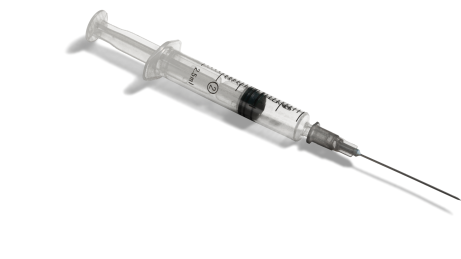Hepatitis D is caused by a Single-stranded RNA virus called the Hepatitis D Virus (HDV) which is also known as delta virus. This is the only virus that never had direct contact with a healthy patient but it infects the patient which already infected with the hepatitis B virus. Hepatitis D is also a liver infectious disease that causes the liver to be inflamed.
This inflammation can lead to severe liver dysfunction which causes other problems such as cirrhosis. Same as hepatitis B it can also affect the spleen and pancreas when left untreated. Although Hepatitis is rare in many countries yet it has an impact on people across the globe.

Structural representation of infected liver from Hepatitis D:
Every hepatitis virus has a unique structure to cause an infectious disease in humans. As HDV needs Hepatitis B virus to complete its replication so they both have some same structures. Hepatitis D virus has:
- Envelop Spherical structure
- Genome: Single-stranded, negative-polarity, circular RNA.
- Baltimore class: V
- No polymerase in the virion.
- HDV has one serotype (because HBV has only one serotype).
- No protein for replication.
Hepatitis D transmission:
As we all know that hepatitis D is caused by HDV. HDV is spread directly with blood and other body fluids. Other body fluids include vaginal fluid, semen, blood serum, urine and, CSF. Hepatitis D spread from mother to offspring is quite low but it can spread during birth.
As I told you earlier for hepatitis D infection, hepatitis B is necessary so it can also be spread indirectly through contaminated syringes, needles, and blades, etc. One must avoid the unscreened transfusion if he or she wants to be safe from any hepatitis Specially hepatitis D. It is estimated that 5 percent of people go onto Hepatitis D from Hepatitis B.
Symptoms of Hepatitis D:
Hepatitis D has the same symptoms as Hepatitis B. the only difference is hepatitis D shows more chronic symptoms than hepatitis B just because hepatitis D is always transmitted when already the body immunity is weak due to Hepatitis B infection.
This then cause’s superinfection as two of the different virus has covered up your liver. Symptoms don’t have to come if both of the viruses have caused an infection. The symptoms are:
- Fatigue and persistent fever
- Nausea and vomiting
- Loss of appetite
- Abdominal cramps and pain
- Frequent dark urination
- Jaundice


With this when left untreated it leads to liver cancer (liver cirrhosis). This is a serious complication that leads to serious discomfort.
Laboratory diagnosis:
At first, if you feel these symptoms you must visit a doctor as soon as possible. Your doctor will do a blood test to detect anti-hepatitis D antibodies in your blood to get an accurate diagnosis. Antibodies indicate that you have been exposed to the virus. High levels of anti-HDV immunoglobulin G (IgG) and immunoglobulin M (IgM) are used to diagnose HDV infection, which is confirmed by the presence of HDV RNA in the blood.

However, HDV diagnostics are not commonly available, and HDV RNA assays, which are used to assess antiviral medication response, lack uniformity. Other than this when hepatitis D leads to a chronic state then doctors recommend LFT and liver biopsy as well to check the liver Dysfunction and cirrhosis respectively.
Hepatitis D treatment:
Likewise Hepatitis B, Hepatitis D also needs to be prevented not treated. It is very important to save yourself from hepatitis D while already infected with hepatitis B because it seriously leads to severe discomfort. For treatment of an infected person, alpha-interferon is given to treat hepatitis D.
This interferon should be given to the patient for at least 8 months to 10 months and checking the viral load from time to time for response. Immuno-compromised patients are not given the tablets without the doctor’s advice. Some patient also needs the medication for the symptoms he is facing such as vomiting, nausea, and fever.
Hepatitis D prevention:
There is no such therapy for Hepatitis D on its own. Other than this the vaccine for hepatitis B is used to prevent hepatitis D. A Child should receive a proper dose of the hepatitis B vaccine so that he or she might not get both the virus in the future. Before this when a person is already infected with hepatitis can’t be saved from hepatitis D because no vaccine act against it then.
Other than this a person needs to follow some general protocols that are given by the WHO for prevention. These protocols are common as all of the types of hepatitis Viruses could be saved to have contact with any healthy person. Some of the basic preventions are:
- Do not share needles
- Do not share shaving blades and Combs
- Do not use someone’s things like toothbrushes, razors, towels, etc.
- Use proper screening of blood and do not touch blood directly with hands.
- Use gloves and masks if you are medical health professionals. Avoid direct contact with syringes and needles.
- Eat healthy fruit and vegetables and drink plenty of water. Avoid raw or uncooked food.


FAQs
What is hepatitis D?
Hepatitis D is a liver infectious disease caused by a Single-stranded RNA virus called the Hepatitis D virus (HDV) which is also known as delta virus. This is the only virus that never had direct contact with a healthy patient but it infects the patient which already infected with the hepatitis B virus.
How do you get hepatitis D?
We can get hepatitis D by direct and indirect contact with the body fluids of an infectious person. Body fluid includes Blood, vaginal fluid, semen urine, etc. Unscreened transfusion, sexual intercourse, and infected needles spread the virus into a healthy person.
What is the difference between hepatitis B and hepatitis D?
There is a lot of difference between Hepatitis B and hepatitis D. the structure of the virus, the mode of transmission, and also the treatment ways are difficult for both hepatitis B and hepatitis D. Although HDV always needs HBV for its spread doesn’t mean they are same.
Conclusion and Doctors Recommendation:
A doctor always advises having a simple and healthy lifestyle in which you have to eat healthy drink healthy and do healthy exercise so that you can yourself from not only hepatitis but every other disease. for hepatitis, there are a lot of Health departments working all over the world so that people could be saved from this infectious disease.
As we know that CDC recommends that to save yourself from hepatitis you must have been vaccinated after 24 hours of birth. Same as WHO gives us a new theme that “hepatitis can’t wait” to acknowledge the urgency of hepatitis elimination to achieve the 2030 elimination targets.
Also WHO have changed their approach towards the eradication of hepatitis D and all other viral hepatitis by raising awareness, preventing transmission mode, and also increasing the health care capacity.
